What Causes Cracks in Brick Walls – And How Can You Fix It?
- Milan Mrmos
- 5 days ago
- 18 min read
Updated: 4 days ago
Cracks in brick walls can appear in homes, buildings, or fences, and many people do not know why they form or how serious they might be.
Some cracks are harmless, but others can point to larger problems. The material, weather, moisture, and even small shifts in the ground can all lead to cracking.
In the following article, you will learn what causes different types of brick walls to crack, how to recognize the warning signs, and what repair methods work best.
What Causes Brick Walls to Crack?
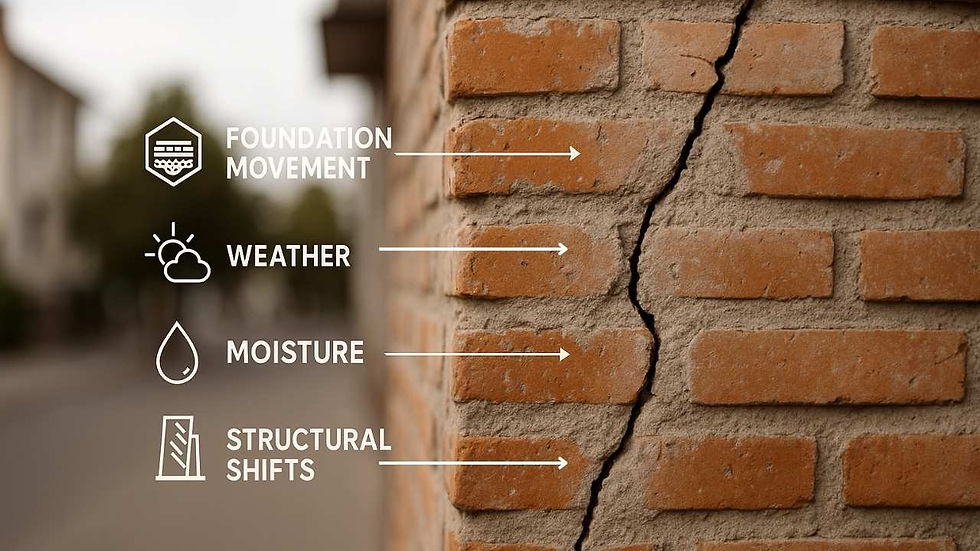
Brick walls do not crack without a cause. Every fracture, split, or separation in a brick surface points to a specific stress or weakness.
In most residential and light commercial buildings, cracks form due to structural movement, changes in temperature, moisture exposure, or installation defects.
Each of those conditions affects the wall differently, and each one leads to recognizable types of damage.
A brick wall must resist gravity, weather, ground shifts, and thermal forces. Brick is a hard material, but it cannot bend or stretch.
That makes it vulnerable once movement begins in the foundation, soil, or supporting frame. A minor shift in one section of the wall often leads to a visible crack.
The shape, width, and location of that crack reveal the source of the stress. Recognizing what caused the problem is the only way to choose the correct repair method.
Homeowners with no construction background can still detect early signs of brick damage. It only takes clear guidance, patience, and a few simple tools. Once the root causes are understood, proper action can follow.
Foundation Settlement and Soil Movement
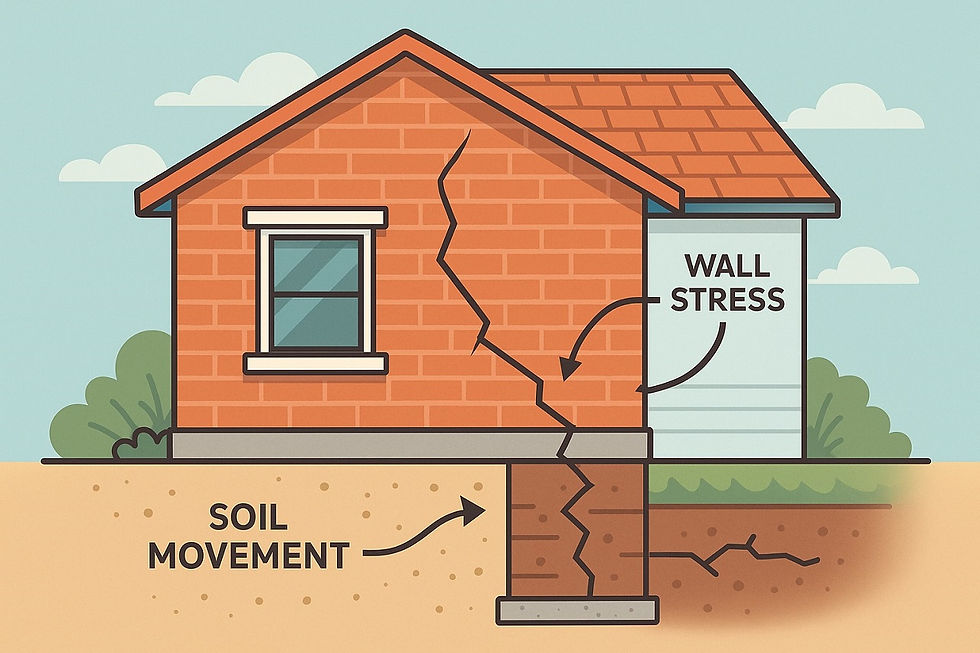
Most brick cracks begin with pressure from below. The soil under a home can shift, compress, or sink, and when it does, the structure above loses its balance.
Cracks appear in the masonry as the wall tries to adjust. No amount of surface patching will work unless the issue beneath the surface is stabilized.
Small movements in the ground are common. Over time, they become more noticeable, especially around corners, windows, and door frames. The building begins to drop unevenly, and brick walls are forced to absorb the strain.
Because brick cannot stretch or flex, it begins to separate along mortar joints or break across the brick faces themselves.
No part of a wall is immune. If the foundation sinks on one end, cracks may appear near the roof line. If soil movement affects the center of the building, stair-step cracks often develop across the middle of the wall.
Uneven Ground Causing Brick Cracks

Some soils hold their shape better than others. Sandy soils drain quickly and do not change volume easily.
Clay-heavy soils behave very differently. When dry, they shrink. When soaked with water, they swell. That change in size places enormous pressure on any structure built above it.
If the soil under one side of a foundation becomes saturated during a storm, it might push that section of the house upward. When that area dries out again, the house drops. That motion causes cracks to open across the brick.
You may see diagonal lines running upward from the bottom corners. In some cases, a vertical crack forms near the center and grows outward.
Each one of those cracks is a sign of movement. The wall is responding to shifts below it, and each response leaves a trace. The width and direction of those cracks can help you determine how the ground is behaving.
Expansive Clay Soil and Wall Shifting
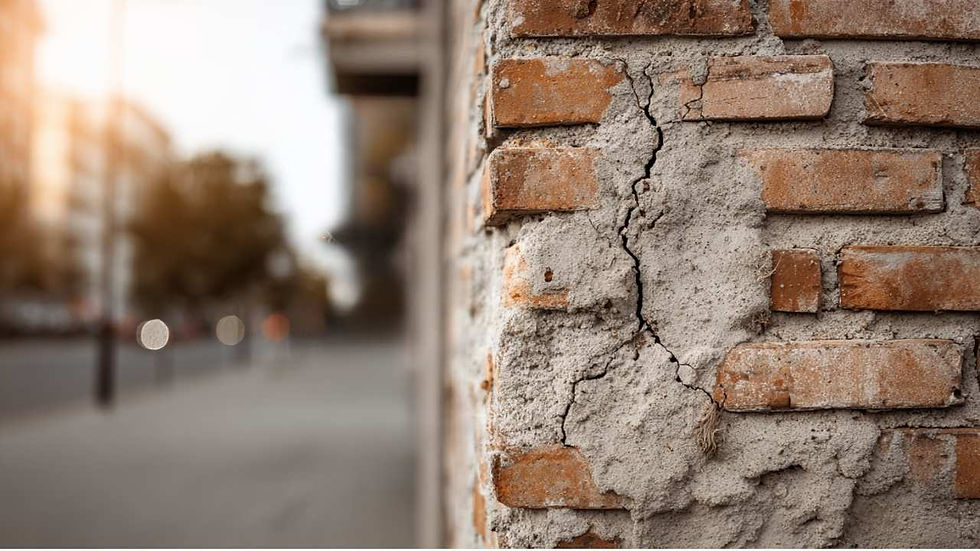
Clay-rich soil is one of the most active types of soil under a foundation. It absorbs water during wet seasons and dries out during periods of heat.
That causes the ground to expand and contract again and again. Over the years, the structure sitting above it will settle into a new shape, and the brick walls will begin to reflect that change through visible damage.
You may notice that cracks appear in a specific season and fade slightly in another. In spring, when the soil swells, the wall may bulge slightly outward. Later in summer, cracks may shift or widen in different directions.
This movement is not surface-level. It comes from the foundation moving up and down in cycles that apply constant pressure to the rigid outer wall.
If the home does not have proper drainage or if water pools around the base of the wall, clay soil reacts even more aggressively.
Cracks will then grow wider and travel higher. Over time, parts of the brick surface may even detach or begin to lean. In the worst cases, the wall can split from the house entirely.
Types of Cracks in Brick Walls
Not all cracks are the same. Some appear as fine lines in the mortar, while others travel through bricks in wide, jagged patterns.
Each shape, direction, and depth tells a story about what is happening behind the surface. Before any repair begins, it is essential to identify the crack type accurately.
That detail alone can point directly to the root cause and reveal whether the issue is cosmetic or structural.
Cracks may form slowly over time or appear quickly after a weather event, soil shift, or construction error. Some remain unchanged for years. Others grow season by season.
By observing their behavior and placement, a homeowner can often tell which ones need urgent attention and which ones require simple maintenance.
Hairline Cracks in Mortar or Brick
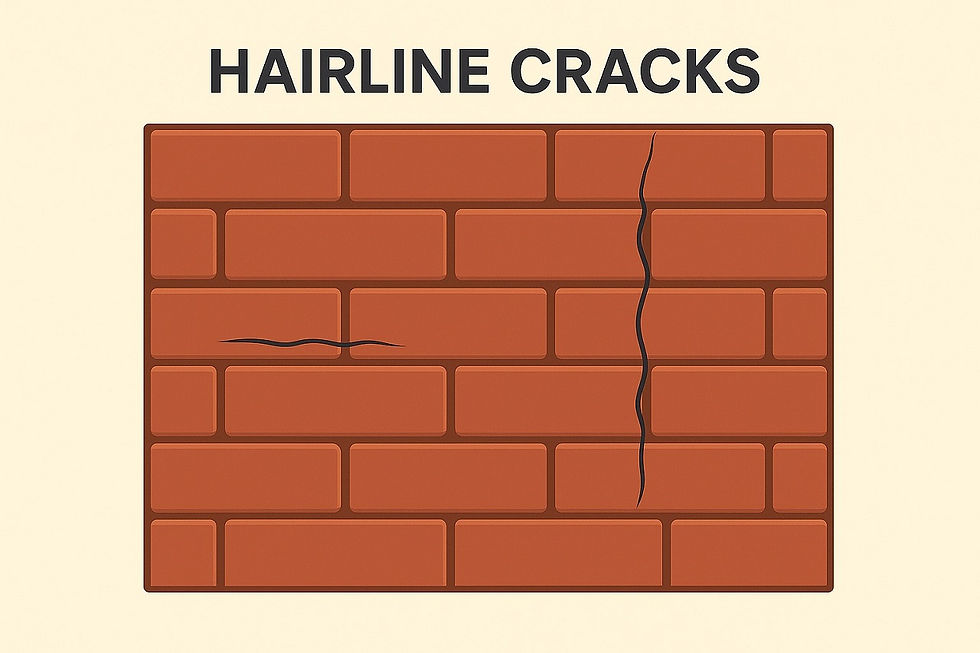
Hairline cracks are narrow and usually shallow. Most are caused by minor drying shrinkage, temperature changes, or early foundation settling.
They often appear within the first year of construction as materials adjust to local conditions. These cracks do not always require urgent repair, but they should never be ignored.
A hairline crack running along a mortar joint might seem harmless, but if it begins to grow, or if water enters the joint, the problem will worsen.
Cracks of this type should be sealed using flexible masonry sealant to keep moisture out and prevent freezing damage in cold climates. If ignored, what began as a cosmetic flaw may turn into a serious pathway for decay.
Hairline cracks in the brick itself, rather than the mortar, suggest stress that the brick could not resist. Even though the crack may appear small, its location matters.
Cracks running through the center of the brick rather than along the joints indicate internal pressure or material fatigue.
Vertical Cracks in Brick Walls
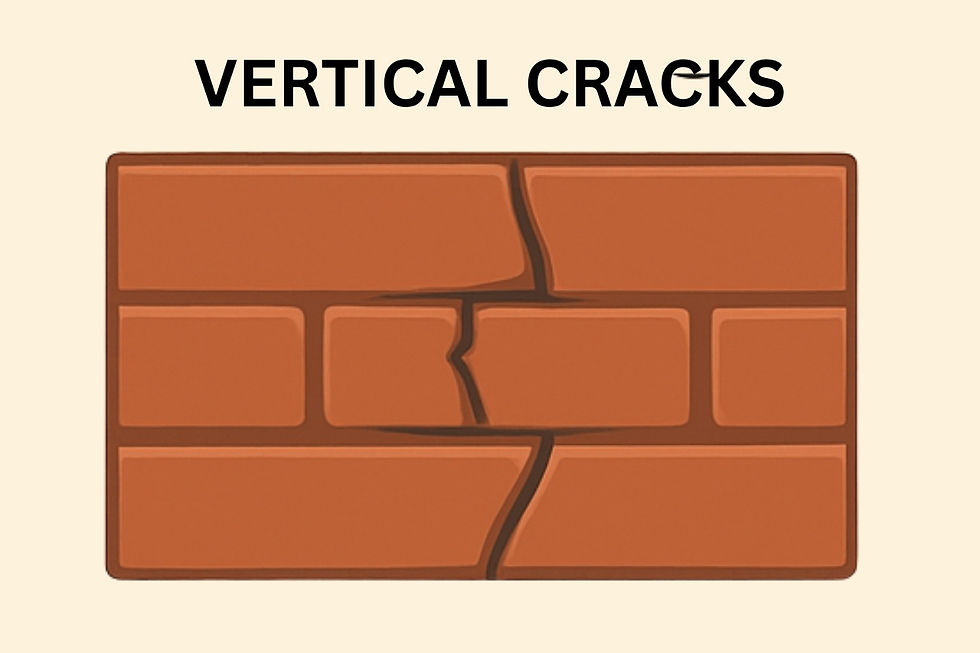
A vertical crack is usually a response to foundation movement, often caused by settling, soil changes, or weight redistribution.
These cracks often appear directly above windows, doorways, or mid-wall sections, and they tend to run straight up or down.
If they are narrow and not growing, they may be cosmetic. But if they widen over time, that indicates a shift in the support system.
One key detail to observe is the direction and symmetry. A vertical crack that runs from the base to the top of the wall in a single line often suggests uniform settling.
That means the whole wall section is dropping in unison. In contrast, an offset vertical crack, especially one that bends slightly or splits, may point to uneven movement and requires closer inspection.
Cracks that run vertically through brick units themselves rather than only through mortar joints are more serious. The brick is breaking under tension, and that tension is likely coming from below.
In most cases, vertical cracks must be sealed to prevent moisture intrusion, but if they continue to expand or if they affect multiple rows of brick, further investigation is needed.
Stair-Step Cracks Around Doors and Windows

Stair-step cracks are among the most common patterns seen in brick walls. They follow the path of mortar joints, moving in a stepped diagonal pattern that resembles a staircase.
These cracks often begin near corners or openings where stress naturally collects.
If a crack begins at the corner of a window or door frame and moves diagonally upward, that usually points to foundation settling or frame movement.
Mortar is the weakest link in a brick wall, so the pressure follows that line first. Even small foundation changes can cause this pattern to appear, and if the crack grows, it may signal that the footing under that section of the wall is sinking or shifting.
If the wall is made of brick veneer, a stair-step crack might not always mean the structure itself is failing. It could be the brick facing pulling away from the frame. But if the wall is load-bearing, that same crack could signal a developing structural fault.
Width, depth, and location are all clues, and any pattern that shows widening over time should be addressed without delay.
Horizontal Cracks from Structural Pressure

A horizontal crack running across a brick wall usually points to external force pressing inward or outward.
This type of crack is not caused by age or weather alone. It often comes from basement wall bowing, foundation pressure, or steel lintel expansion. In each of these cases, the crack shows that the wall is struggling to resist lateral force.
If a horizontal crack appears near the base of a wall, it might indicate soil pressure pushing inward. That often happens in basements where groundwater buildup causes heavy force against the wall.
If the crack appears above a window or garage opening, it could point to a steel lintel expanding due to rust or sagging from overload.
It is often the first sign of a larger issue involving pressure that could lead to wall failure. A professional inspection is always recommended once a horizontal crack is discovered.
Spider-Web or Map Cracking on Surface

Map cracking looks like a net of tiny fractures that resemble a spider web or a road map. These cracks stay close together and rarely follow any straight line. They usually form on plaster or painted brick surfaces rather than in deep masonry.
Map cracks are often caused by surface shrinkage, poor curing, or the use of incompatible coatings. Though they are usually not structural, they signal a failure in surface preparation or moisture control.
If left untreated, water can find its way through those tiny openings and start deeper damage.
The best approach to map cracking is removal of loose material, followed by sealing and resurfacing. While not dangerous on their own, these cracks should be handled early to prevent future problems.
Bulging Walls and Loose Bricks

A bulge in a brick wall is more than cosmetic. It means that the wall has begun to shift or separate from its support.
This often results in cracks that run along the top or bottom edge of the bulge, sometimes with visible brick displacement. If bricks feel loose to the touch or if gaps appear around them, immediate attention is needed.
Causes include moisture trapped behind the brick, corroded anchors, or inner wall movement. In some cases, bulging results from freeze-thaw cycles that push the wall outward.
Whatever the cause, this condition cannot be repaired with surface sealants. It must be stabilized, and loose sections may need full removal and reconstruction.
How to Check for Brick Wall Damage?
Cracks in brick walls are not always easy to understand at first glance. Some may seem minor but point to deeper structural issues. Others may look alarming but only affect surface materials.
Before starting any repair, you must inspect the wall carefully and record what you see. Even beginners can perform a reliable assessment using basic tools, clear steps, and close attention to detail.
Start at ground level and examine the entire wall, section by section. Look closely at areas near windows, doors, corners, and the base of the wall. Cracks near the foundation often come from settling.
Cracks higher up may point to roof pressure, frame shift, or temperature stress. Understanding the location will help you determine the source.
A clear record of crack shape, size, direction, and position will help you decide what action is needed. You do not need advanced tools. You only need consistency, patience, and a good look at the entire wall.
Tools to Use for Brick Wall Inspection
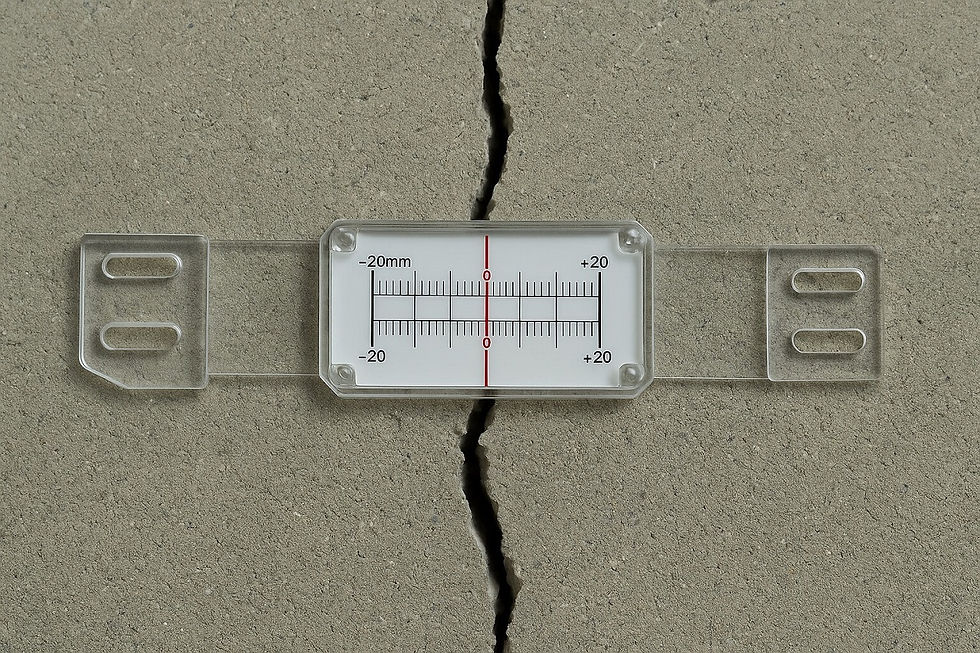
You can complete most inspections with simple items found at any hardware store. Use the tools listed below to make your check more precise:
Tape measure or caliper – Measures the crack width
Pencil and notepad – Marks crack ends and records dates
Smartphone or camera – Captures clear pictures over time
Flashlight – Lights up deeper cracks or wall shadows
Spirit level or plumb line – Checks for leaning or bulging
Crack monitor (optional) – Tracks movement with clear readings
Take measurements at both ends of the crack. Record how wide it is at the top, middle, and bottom. Use a pencil to draw a short line across each end of the crack.
Write the current date beside each mark. Repeat this process once a month, or after heavy rain, snow, or dry periods.
Watch for patterns. If the crack expands past your original marks, that means movement is still active.
What to Look For During Inspection
When checking your brick wall, focus on the following signs. Each one may show that the problem is more serious than it first appears:
1. Direction of the Crack
Vertical cracks may show uniform settling
Stair-step cracks often mean one side of the foundation is dropping
Horizontal cracks may point to soil pressure or wall bowing
2. Location of the Crack
Cracks near the base may come from soil movement
Cracks near windows or doors often result from stress at weak framing points
Cracks in the center of the wall may reflect downward pressure from the roof
3. Width and Shape
Hairline cracks are usually cosmetic
Wide or jagged cracks often suggest active movement
Wider at one end usually means uneven settling
Warning Signs That Require Close Attention

Cracks become more serious when they are paired with other physical changes in the home. Check the areas around the wall for additional signs of movement. Look for:
Doors that stick or no longer close smoothly
Windows that shift or tilt in their frames
Gaps between window frames and brick edges
Cracks in interior drywall that line up with exterior brick cracks
Uneven floors or separation at baseboards
Proper Repair Methods
Once the cause of a crack is understood, the next step is to apply the correct repair method. The repair must match the size, depth, and location of the crack.
A shallow mortar crack caused by shrinkage needs a different approach than a deep break running through full bricks. Not all damage can be fixed with surface treatments, and not every crack means structural failure.
Choosing the right method prevents wasted effort, repeat damage, or cosmetic cover-ups that fail to last.
Repair materials must be compatible with the original construction. For example, a lime-based mortar wall should never be patched with hard Portland cement.
The mismatch will cause even more cracking in the future. The repair must allow the wall to expand and contract normally while sealing gaps against moisture and further stress.
How to Fix Hairline Cracks in Brick Walls?

Hairline cracks can be sealed with flexible masonry caulk or injected with a small amount of bonding agent.
First, the crack must be cleaned of dust, loose mortar, or surface film. A small wire brush or compressed air may be used. If the crack is too narrow for any sealant to penetrate, widen it slightly using a utility knife or masonry blade. That creates enough space for a lasting bond.
After cleaning, apply the caulk along the entire length of the crack. Smooth it using a putty knife or damp sponge. Do not overfill or leave thick ridges. The goal is to allow flexibility while keeping out water and debris. Choose a product labeled for brick and mortar, with UV resistance if the crack is exposed to sunlight.
If the crack passes through the brick rather than just the mortar, the same method can apply if the depth is shallow. Deeper fractures may require removal and replacement of the brick itself.
Repointing Mortar in Damaged Brick Joints
Repointing is the process of removing old mortar and packing new mortar into the joints between bricks.
The repair is needed when the mortar has cracked, fallen out, or separated due to weathering or movement.
To repoint, use a hammer and cold chisel or a mortar raking tool to remove at least 1.5 centimeters of old mortar. Vacuum or brush out all dust. Wet the joint lightly to slow drying and improve adhesion.
Mix fresh mortar that matches the original type and color as closely as possible. For older homes, lime mortar may be required instead of modern Portland mixes.
Pack the mortar firmly into the joint using a pointing trowel. Tool the surface to match the finish of surrounding joints. Allow the new mortar to cure slowly over several days. Keep it moist and protected from wind and direct sun during the curing period.
Repointing can restore both appearance and strength. If only mortar is affected and bricks remain intact, repointing alone may be enough to stop further cracking.
Replacing a Cracked or Broken Brick
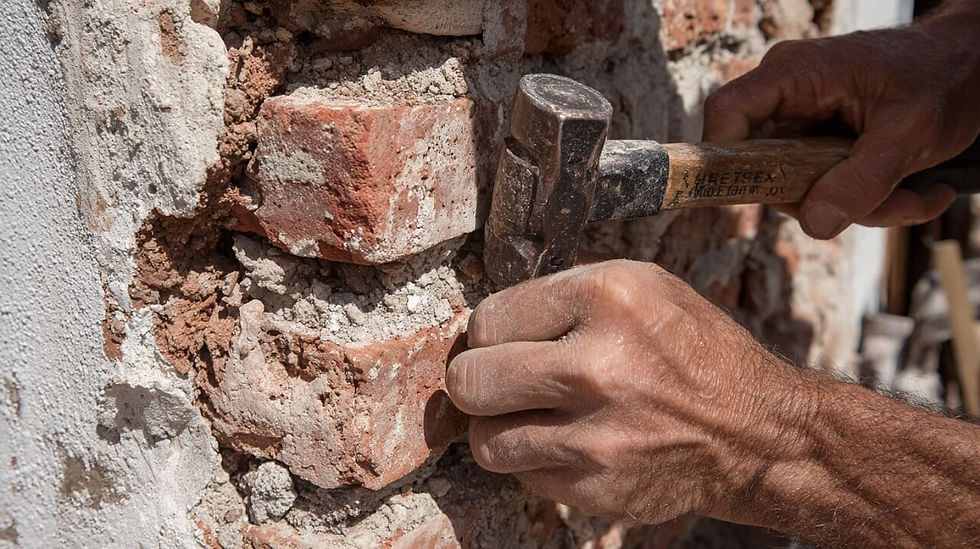
When a brick is cracked through its core or has begun to crumble, it must be removed and replaced. This process requires care to avoid damaging nearby bricks.
Use a drill to weaken the brick face by making small holes across the surface. Then break the brick into sections using a hammer and cold chisel.
Remove all pieces, including any mortar still attached to the edges.
Clean the cavity completely.
Butter a new brick with fresh mortar on all sides except the front face.
Slide it into the cavity and press firmly into place.
Fill surrounding joints with the same mortar, then tool the surface to match.
Wipe off any excess mortar before it hardens.
Allow the new brick to cure undisturbed. Avoid pressure, vibration, or cleaning until the mortar has set completely. This method restores both function and appearance when isolated damage has occurred.
Applying Masonry Caulk or Sealant
Caulking is used when flexibility is more important than hardness. Many hairline and seasonal cracks move slightly during the year. If rigid mortar is used in those cracks, it will break again quickly.
Use a polyurethane or silicone-based masonry sealant. Choose a product made for exterior brick that remains flexible. Apply it after the surface is fully cleaned and dry.
For best results, mask both sides of the crack with painter’s tape. Apply the caulk directly into the crack and smooth it while still soft. Remove the tape before it cures.
This method is ideal for controlling small cracks without altering the appearance of the wall. It also prevents water intrusion and freeze-thaw expansion, which are major causes of future damage.
When to Use Epoxy or Crack Stitching?
If a crack runs deep or continues to move, standard patching will not be enough. Epoxy injection fills deep structural cracks and bonds the wall from within. Crack stitching uses stainless steel bars embedded across the crack to hold the wall together.
Both methods require skill, proper tools, and an accurate understanding of the wall structure. In most cases, these repairs are handled by professional masons or structural contractors.
Do not attempt epoxy injection or stitching without full knowledge of the materials involved. If done incorrectly, these repairs can trap moisture or cause future expansion to break the wall again.
Waterproofing Repairs After Sealing Cracks
Once a crack is sealed, the entire wall must be protected against water intrusion. That includes applying a breathable masonry sealer across the wall face. The product must allow vapor to escape while blocking rain, snow, or ground moisture.
Before sealing, inspect every joint, corner, and transition for open gaps. Use caulk or mortar to fill anything that might allow water to enter.
Then apply the sealer with a roller or sprayer, covering all repaired areas and adjacent surfaces. Let the wall dry fully before exposing it to weather.
Sealing without waterproofing is a wasted effort. The goal is not only to close the crack, but also to prevent the same condition from returning.
How to Repair Different Types of Brick Walls?
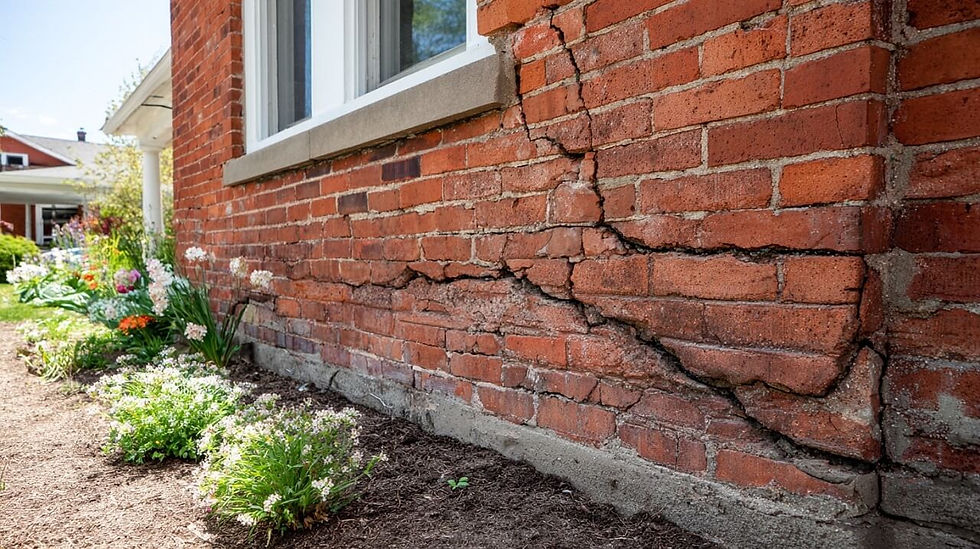
Not every brick wall is built the same way. Some are structural and support the building. Others are thin coverings attached to wood or concrete.
Each type responds differently to damage. If the wrong method is used, the repair will fail or even cause further cracking.
To choose the right repair, you must first identify the wall type. Look at the depth of the bricks, the material behind them, and how they are joined. Once that is clear, you can follow the right process based on the wall’s function and structure.
Thin Brick Wall Crack Repair
Thin brick is made of slices of brick material attached to panels or backboards. It does not carry structural load. Cracks often form when adhesive fails, panels move, or water enters behind the surface.
To repair thin brick, begin by removing any loose pieces. Clean the backing thoroughly and allow it to dry. Use a construction-grade adhesive designed for thin brick. Press the brick piece back in place and seal the edges with a matching grout or flexible sealant.
If several pieces are affected, inspect the entire section. You may need to remove and rebuild a larger area. Always finish with a breathable masonry sealer to protect the surface from moisture.
Brick Veneer Crack Repair
Brick veneer is a single layer of full-sized brick tied to a wood or concrete wall. It protects the building but does not carry the main weight. Most cracks in veneer follow the mortar joints and form stair-step or vertical patterns.
Small cracks can be sealed with caulk or repointed. Larger cracks, especially near windows or doors, may require lintel inspection or reinforcement.
Always check the weep holes at the base of the wall. If they are blocked, moisture may be trapped, which leads to freeze-thaw cracking.
If the crack runs through the brick, replacement is needed. Always match the new brick and mortar to the original surface. Repairing veneer incorrectly can cause visible lines or weak bonds that lead to new damage.
Structural Brick Wall Crack Repair
A structural brick wall carries the weight of the building above it. Cracks in this kind of wall are more serious. They must be evaluated based on depth, pattern, and direction.
Hairline cracks in old mortar may only need repointing. But any crack that passes through the brick itself, especially in a load-bearing section, must be reinforced.
Crack stitching may be required. In some cases, partial rebuilding or foundation repair is necessary.
Do not attempt structural brick repair without a full understanding of load paths and wall connections. Mistakes in structural repairs can lead to wall failure or collapse.
If the wall leans, bulges, or separates from the rest of the building, stop all work and contact a licensed contractor.
Cost to Repair Cracked Brick Walls
Repair cost depends on crack size, wall type, material match, and site conditions. Minor surface cracks may cost less than $500 to repair if only sealant or mortar is needed.
Repointing a larger section of wall could range between $1,000 and $3,000. Full brick replacement, crack stitching, or foundation repair may range from $3,000 to over $10,000 depending on severity.
How to Prevent Cracks in Brick Walls?
The best way to manage brick wall cracks is to stop them from forming. Preventive care reduces the chance of structural movement, moisture infiltration, and material failure. Even basic actions, when done consistently, can protect the wall for decades.
Prevention focuses on three main areas: moisture control, proper materials, and regular inspection. Homes in regions with clay soil, extreme temperature shifts, or heavy rainfall must be even more careful.
Prevention is always more cost-effective than repair.
Improve Drainage Around Brick Walls

Water is the most common cause of stress in brick structures. It enters through small openings, pools near foundations, and weakens the soil below. To keep water away from the wall, follow these actions:
Extend downspouts at least 3 feet away from the foundation
Maintain clean, unclogged gutters all year
Grade soil to slope away from the base of the wall
Use gravel or drain tile in problem areas
Avoid planting heavy shrubs directly against the wall
If water is trapped near the wall, it can lead to freeze-thaw expansion, soil swelling, and mortar decay. Each of those can lead to visible cracking in a matter of seasons.
Gutter Extensions and Sloped Soil
If the ground next to your home stays wet, pressure builds against the brick wall. A gutter extension costs very little and may reduce that pressure overnight.
Slope the soil so it drops at least 1 inch per foot for the first 4 to 6 feet away from the home.
Sealing Brick Walls with Breathable Products
Masonry sealer is a critical step after repairs. Use a product that allows vapor to escape while blocking outside moisture.
Never use paint or surface film coatings, which will seal in vapor and cause long-term wall damage.
Apply sealer using a roller or low-pressure sprayer. Cover all mortar joints and brick faces. Focus especially on corners, window edges, and any repaired areas.
Reapply every 5 to 7 years, or as recommended by the manufacturer.
Use Proper Construction Materials
If building a new wall or making major repairs, choose materials that match the climate and brick type.
Mortar that is too hard can crack soft brick. Thin brick must use the right adhesive and backer. Brick veneer must be tied and spaced correctly to allow drainage.
Never mix Portland mortar into older lime-based structures unless guided by a restoration expert. Hard mortar on a soft brick wall will lead to stress, especially during temperature swings.
Avoid Tree Roots Near Brick Foundations
Large trees should never be planted near foundations. Their roots draw moisture from the soil, causing it to shrink. They can also press directly against buried footings or wall bases. Both results lead to cracks in walls above.
Keep trees at least 10 feet away from any brick wall. For large species like oak or maple, increase that distance to 20 feet. If a tree is already too close, consider installing a root barrier between it and the wall.
Check Brick Walls Regularly for Small Cracks
Do a full inspection of your brick walls at least twice a year. Focus on areas near corners, windows, doors, and where the wall meets the foundation. Use a flashlight and a measuring tool. Mark anything that changes.
Catching small cracks early allows you to fix them before water, insects, or seasonal movement make the damage worse. Preventive care saves more money than any repair.
Last Words
Strong brick walls stay that way when problems are caught early and handled the right way. That means sealing hairline cracks, reinforcing deeper breaks, and calling a professional when structural damage appears.
With the right tools, the right knowledge, and the right action, any homeowner can protect their brick walls for the long term.




Comments